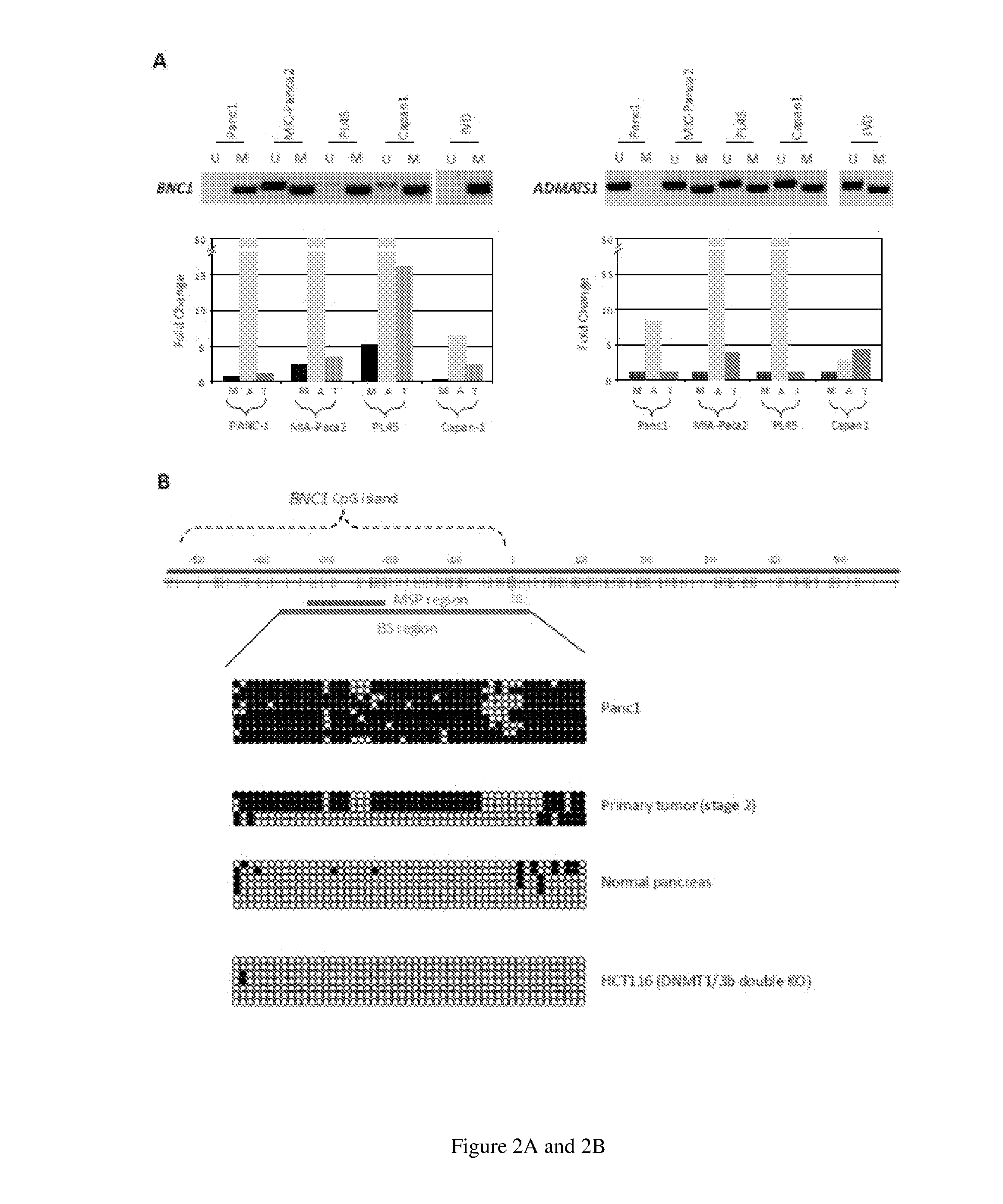Compositions and methods for detecting a neoplasia
a neoplasia and composition technology, applied in the field of compositions and methods for detecting neoplasia, can solve the problem that no screening tool is currently available for early detection
- Summary
- Abstract
- Description
- Claims
- Application Information
AI Technical Summary
Benefits of technology
Problems solved by technology
Method used
Image
Examples
example 1
Identification of Cancer-Specific Promoter Methylation Candidate Genes in Pancreas Hypermethylome
[0084]In order to identify new DNA methylation biomarkers for pancreatic cancer, previously established whole human transcriptome microarray screening was used to identify genes silenced by promoter hypermethylation. To identify global hypermethylation-dependent gene expression changes in pancreatic cancer, a genome-wide expression array-based approach was performed in four different human pancreatic cancer cell lines (PL45, MIA-PaCa2, Panc1, and Capan1) with a pharmacologic strategy using 5-aza-deoxycycytidine and Trichostatin A (TSA) using standard array-based methodology (e.g. Agilent Technologies 44K). As seen in FIG. 1A, a total of 1,427 unique genes were initially identified in four cell lines, which met the criteria for candidate hypermethylated genes in the pancreatic cancer cell lines. In order to identify genes that only showed cancer specific methylation, the following experim...
example 2
BNC1 and ADAMTS1—DNA Methylation Biomarkers for Early Detection of Pancreatic Cancer
[0085]Next, the methylation status of these 8 genes (TFPI2, ASCL2, BNC1, TWIST1, BNIP3, ADAMTS1, PNMT, and EVL) was examined in a large series of primary pancreatic tumor samples (n=143; Stages 1-4) using methylation specific PCR (see Table 1).
TABLE 1Clinical information of pancreas cancer patient primary tumor samples in this studyPancreas Primary tumorsNormalPanINsStage 1Stage 2Stage 3Stage 4(n = 4)(N = 20)(N = 38)(N = 78)(N = 5)(N = 2)Median SurvivalNot Met43.018.014.119.6(months)GenderMale3(75%)9 (45%) 9 (23.7%)44 (57%)1 (20%) 2 (100%)Femal1925%)11 (55%) 29 (76.3%)34 (43%)4 (80%)0.0%GradeWell-9 (45%)3 (7.9%) 4 (5.1%)1 (20%)0 (0%) Moderately8 (40%)23 (60.5%)41 (52%)4 (40%)1 (50%)Poorly3 (15%)12 (31.6%) 33 (42.9%)4 (40%)1 (50%)
[0086]As shown in FIG. 1B, the most frequently methylated gene was BNC1 (90.5%), followed by ADAMTS1 (66.7%), TWIST1 (66.7%), ASCL2 (53.79%), BNIP3 (49%), TFPI2 (53.7%,) EVL ...
example 3
Detection of DNA Methylation in Pancreatic Cancer Patient Sera Using Methylation on Beads Technology
[0089]Early detection of disease results in an improved clinical outcome for most types of cancer. This is particularly relevant for pancreatic cancer, which is poorly accessible and difficult to diagnose. Consequently, 90% of patients with pancreatic cancer present with metastatic or advanced regional disease. Based on the methylation studies, BNC1 and ADAMTS1 have emerged as important biomarkers for the early detection of pancreatic cancer. To determine whether BNC1 and ADMTS1 promoter DNA methylation could be detected in pancreatic cancer patient sera, a highly-sensitive nanoenabled assay, termed methylation on Beads was used, which was developed to improve sensitivity of methylation detection (see, e.g., FIG. 2C). To test the utility of methylation on beads as a tool for early detection of pancreatic cancers, serum samples from a series of pancreatic cancer patients (n=42; stages ...
PUM
| Property | Measurement | Unit |
|---|---|---|
| time | aaaaa | aaaaa |
| fluorescence | aaaaa | aaaaa |
| colorimetric assay | aaaaa | aaaaa |
Abstract
Description
Claims
Application Information
 Login to View More
Login to View More - R&D
- Intellectual Property
- Life Sciences
- Materials
- Tech Scout
- Unparalleled Data Quality
- Higher Quality Content
- 60% Fewer Hallucinations
Browse by: Latest US Patents, China's latest patents, Technical Efficacy Thesaurus, Application Domain, Technology Topic, Popular Technical Reports.
© 2025 PatSnap. All rights reserved.Legal|Privacy policy|Modern Slavery Act Transparency Statement|Sitemap|About US| Contact US: help@patsnap.com



